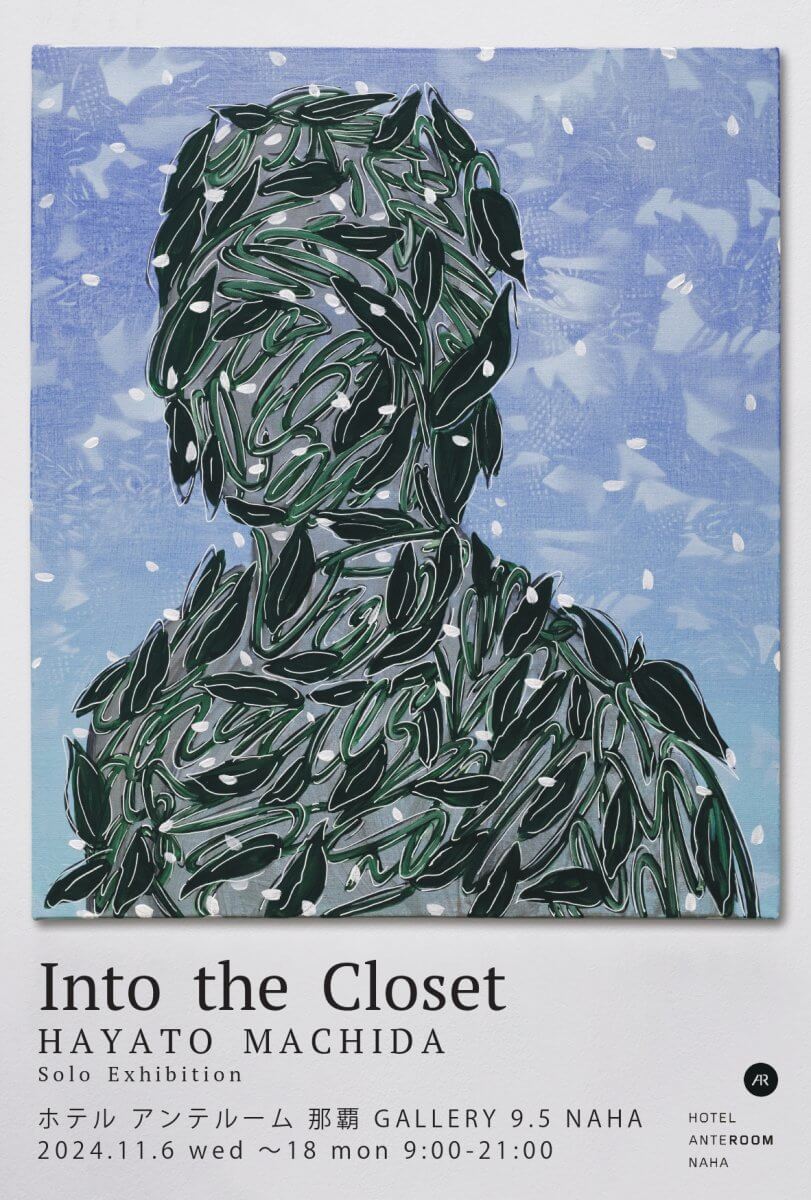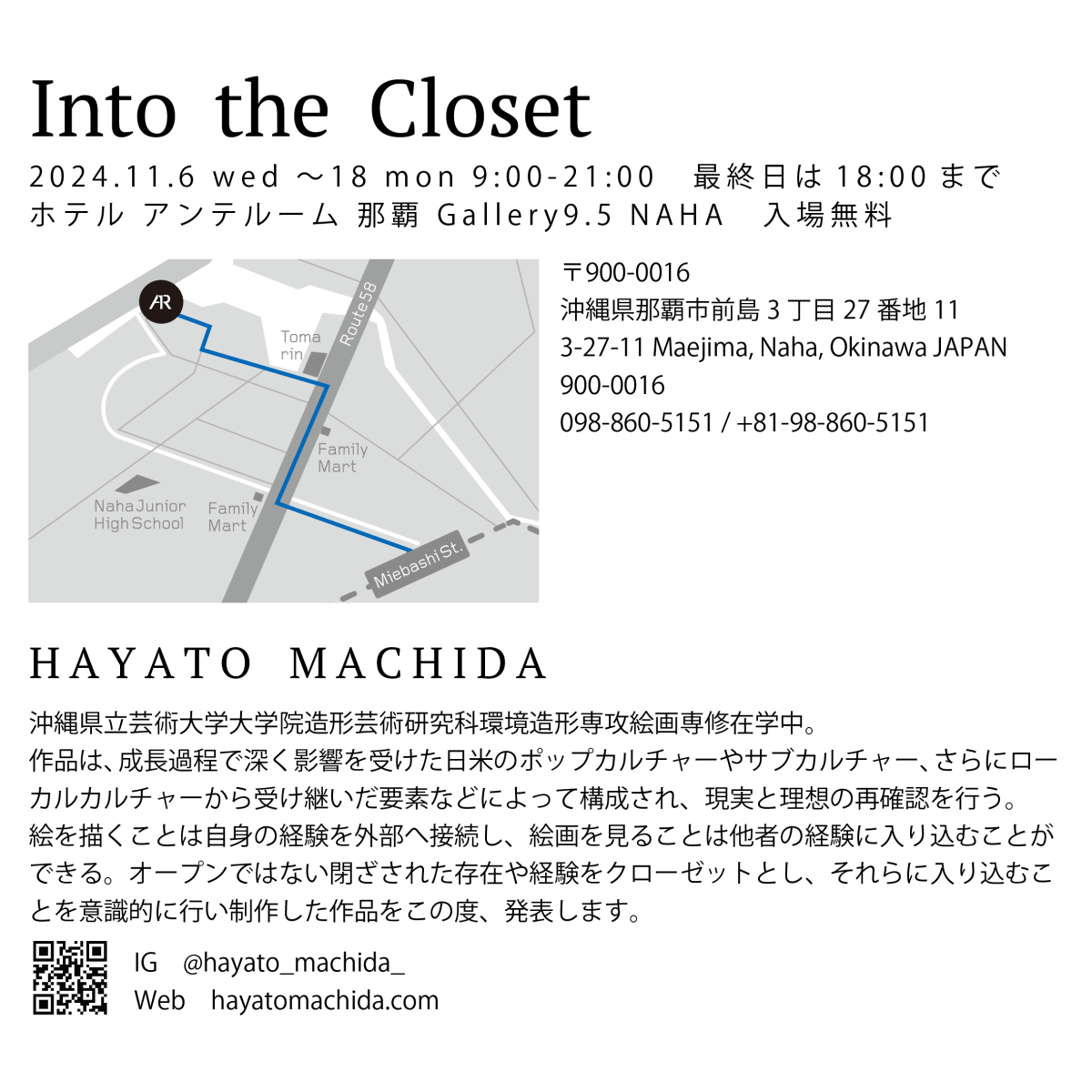
個展『Into the Closet』アンテルーム 那覇
沖縄・アンテルーム那覇Gallery9.5 NAHAにて個展「Into the Closet」を開催致します。
ぜひご高覧ください。
HAYATO MACHIDA 「Into the Closet」
会期|2024年11月6日(水)~11月18日(日)
時間|9:00~21:00 ※最終日のみ18時閉場
会場|ホテル アンテルーム 那覇 Gallery9.5 NAHA
〒900-0016 沖縄県那覇市前島3丁目27−11
入場|無料
・展覧会ステイトメント
大学院進学後に沖縄で初めての個展になります。
今回の展覧会名「Into the Closet(クローゼットの中へ)」のクローゼットとは「何かを隠している状態」を意味する隠語として、使用されます。そのクローゼットに入り込むことは自身を見つめ直す行為であり、同時にそれをオープンにできない社会の状態とは何かという規範意識を揺さぶることに働きかけます。
私にとって絵を描くことは、生存するために必要なことであり、それは小学校高学年の頃から感じた社会規範に当てはまらない外れた存在を自認することから始まります。当時、規範から外れてしまうことは、いじめや差別の対象、時には死刑など極刑になることを感じていたためです。この頃から、生きていくために、今いる環境、社会を打開していくために自分には美術が必要であることを考え始めます。
人の形を模した展示作品(Undress等)では、人間が作り出す社会規範と生物という脳科学的観点から人間について考えた作品です。人間は、自分の内面の一部を他者に見せることを避け、心のクローゼットにしまい込むことがあります。このクローゼットには、恐れや不安、未解決の葛藤、あるいは他者に見せたくない本音が含まれます。心理学的には、これは無意識の領域とも言え、フロイトの精神分析における抑圧やユングの影(シャドウ)の概念に近いものがあります。このように何かをクローゼットの中にしまい込むという行為は、私たちが日常生活で避けたい真実や、自ら直面したくない事柄を象徴するかもしれません。しかし、クローゼットを開けて中の物を取り出すことは、これらの隠れた要素に向き合い、理解しようとするプロセスとも言えます。それは日々、私たちはクローゼットの中から服を選び、それを身につけて外に出て他者に自己を示すように、クローゼットは自己の選択とアイデンティティの形成を象徴する場所とも言えます。私たちは服を選ぶことで、社会的な役割や自分がどう見られたいかという意識を形にします。これは、サルトルの「人間は自由の刑に処されている」という言葉に近いものがあり、クローゼットから選び出す行為は、自らの存在を構築していく一つの象徴的な行為です。このように、クローゼットは私たちの「私的な自己」を守る場でもありながら、パブリックな自己とどのようにバランスを取るかというテーマにも繋がります。


Exhibition Statement
This will be my first solo exhibition in Okinawa after entering graduate school.
The name of the exhibition, “Into the Closet,” is used to refer to the state of hiding something. Going into the closet is an act of self-reflection, and at the same time, it works to shake up our normative awareness of what it is to be in a society that does not allow us to be open about it.
For me, painting is a necessity for survival, and it begins with a self-identification as an outlier that does not fit into the social norms that I have felt since my upper elementary school years. This was because at that time, I felt that to be outside the norm was to be subject to bullying, discrimination, and sometimes even extreme punishment, such as the death penalty. Around this time, he began to think that he needed art to help him break out of the environment and society he was in in order to survive.
The works on display (such as Undress), which imitate the human form, consider humans from the brain-scientific perspective of the social norms and organisms that we create. Humans sometimes avoid showing parts of their inner selves to others and keep them in the closet of their minds. This closet may contain fears, insecurities, unresolved conflicts, or true feelings that we do not want others to see.
Psychologically, this can be described as the realm of the unconscious and is similar to Freud’s repression in psychoanalysis and Jung’s concept of shadows. This act of putting something away in a closet may symbolize truths we want to avoid or things we do not want to face ourselves in our daily lives. However, opening the closet and taking out what is inside can also be a process of confronting and trying to understand these hidden elements. It can be said that the closet is a symbolic place of self-choice and identity formation, as each day we choose clothes from within the closet and wear them out to present ourselves to others. Through our clothing choices, we shape our social roles and our sense of how we want to be seen. This is similar to Sartre’s statement that “man is condemned to freedom,” and the act of choosing from the closet is one symbolic act of constructing our own existence. Thus, while the closet is a place to protect our “private self,” it also leads to the theme of how we balance our public self.
Dates|November 6 (Wed) – November 18 (Sun), 2024
Hours: 9:00 – 21:00 *Close at 18:00 on the last day
Venue|Hotel Anteroom Naha Gallery 9.5 NAHA
Admission|Free